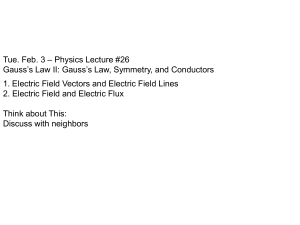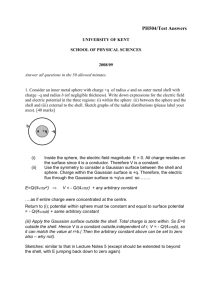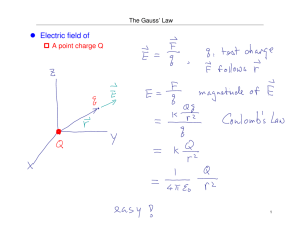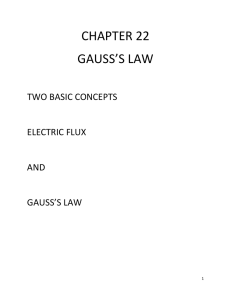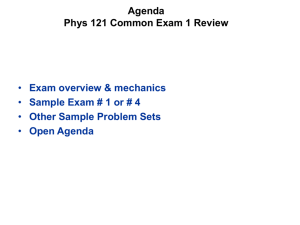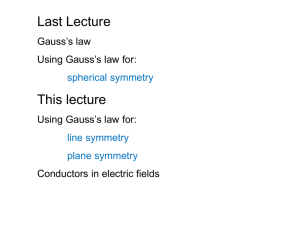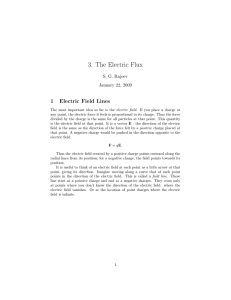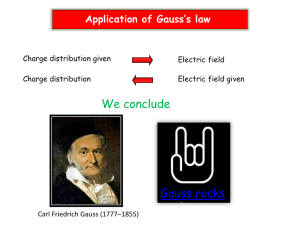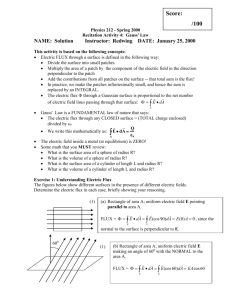Gauss` Law MC Student version ANSWERS
advertisement
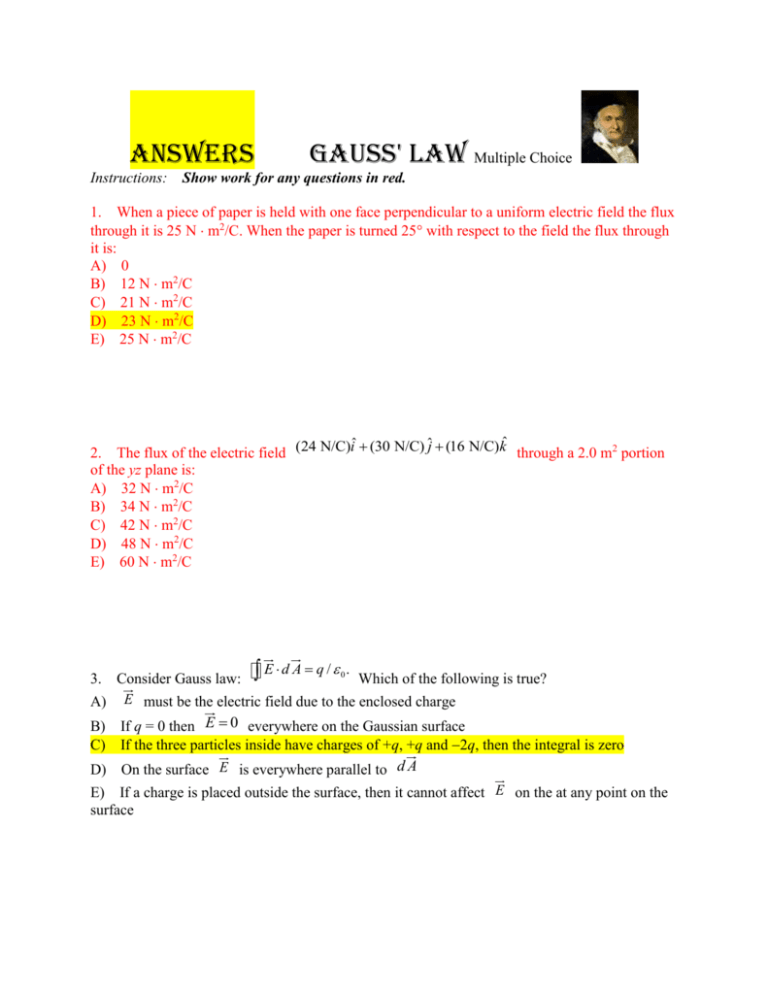
Answers Gauss' LaW Multiple Choice Instructions: Show work for any questions in red. 1. When a piece of paper is held with one face perpendicular to a uniform electric field the flux through it is 25 N m2/C. When the paper is turned 25 with respect to the field the flux through it is: A) 0 B) 12 N m2/C C) 21 N m2/C D) 23 N m2/C E) 25 N m2/C ˆ ˆ ˆ 2. The flux of the electric field (24 N/C)i (30 N/C) j (16 N/C)k through a 2.0 m2 portion of the yz plane is: A) 32 N m2/C B) 34 N m2/C C) 42 N m2/C D) 48 N m2/C E) 60 N m2/C E d A q / 0. 3. Consider Gauss law: Which of the following is true? A) E must be the electric field due to the enclosed charge B) If q = 0 then E 0 everywhere on the Gaussian surface C) If the three particles inside have charges of +q, +q and 2q, then the integral is zero D) On the surface E is everywhere parallel to d A E) If a charge is placed outside the surface, then it cannot affect E on the at any point on the surface 4. A point charge is placed at the center of a spherical Gaussian surface. The electric flux E is changed if: A) the sphere is replaced by a cube of the same volume B) the sphere is replaced by a cube of one-tenth the volume C) the point charge is moved off center (but still inside the original sphere) D) the point charge is moved to just outside the sphere E) a second point charge is placed just outside the sphere 5. Choose the INCORRECT statement: A) Gauss' law can be derived from Coulomb's law B) Gauss' law states that the net number of lines crossing any closed surface in an outward direction is proportional to the net charge enclosed within the surface C) Coulomb's law can be derived from Gauss' law and symmetry D) Gauss' law applies to a closed surface of any shape E) According to Gauss' law, if a closed surface encloses no charge, then the electric field must vanish everywhere on the surface 7. A physics instructor in an anteroom charges an electrostatic generator to 25 C, then carries it into the lecture hall. The net electric flux in N m2/C through the lecture hall walls is: A) 0 B) 25 10–6 C) 2.2 105 D) 2.8 106 E) can't tell unless the lecture hall dimensions are given 8. A point particle with charge q is placed inside a cube but not at its center. The electric flux through any one side of the cube: A) is zero B) is q/0 C) is q/40 D) is q/60 E) cannot be computed using Gauss' law 9. A particle with charge 5.0-C is placed at the corner of a cube. The total electric flux in N m2/C through all sides of the cube is: A) 0 B) 7.1 104 C) 9.4 104 D) 1.4 105 E) 5.6 105 10. A point particle with charge q is at the center of a Gaussian surface in the form of a cube. The electric flux through any one face of the cube is: A) q/0 B) q/40 C) q/40 D) q/80 E) q/160 11. The table below gives the electric flux in N m2/C through the ends and round surfaces of four gaussian surfaces in the form of cylinders. Rank the cylinders according to the charge inside, from the most negative to the most positive. cylinder 1: cylinder 2: cylinder 3: cylinder 4: A) B) C) D) E) left end +2 10–9 +3 10–9 –2 10–9 +2 10–9 right end +4 10–9 –2 10–9 –5 10–9 –5 10–9 rounded surface –6 10–9 +6 10–9 +3 10–9 –3 10–9 1, 2, 3, 4 4, 3, 2, 1 3, 4, 2, 1 3, 1, 4, 2 4, 3, 1, 2 12. A round wastepaper basket with a 0.15-m radius opening is in a uniform electric field of 300 N/C, perpendicular to the opening. The total flux through the sides and bottom, in N m2/C, is: A) 0 B) 4.2 C) 21 D) 280 E) can't tell without knowing the areas of the sides and bottom 15. 10 C of charge are placed on a spherical conducting shell. A particle with a charge of –3-C point charge is placed at the center of the cavity. The net charge in coulombs on the inner surface of the shell is: A) –7 B) –3 C) 0 D) +3 E) +7 16. 10 C of charge are placed on a spherical conducting shell. A particle with a charge of –3C is placed at the center of the cavity. The net charge in coulombs on the outer surface of the shell is: A) –7 B) –3 C) 0 D) +3 E) +7 17. A 30-N/C uniform electric field points perpendicularly toward the left face of a large neutral conducting sheet. The area charge density on the left and right faces, respectively, are: A) –2.7 10–9 C/m2; +2.7 10–9 C/m 2 B) +2.7 10–9 C/m2; –2.7 10–9 C/m 2 C) –5.3 10–9 C/m2; +5.3 10–9 C/m 2 D) +5.3 10–9 C/m2; –5.3 10–9 C/m 2 E) 0; 0 18. A hollow conductor is positively charged. A small uncharged metal ball is lowered by a silk thread through a small opening in the top of the conductor and allowed to touch its inner surface. After the ball is removed, it will have: A) a positive charge B) a negative charge C) no appreciable charge D) a charge whose sign depends on what part of the inner surface it touched E) a charge whose sign depends on where the small hole is located in the conductor 19. Charge is distributed uniformly along a long straight wire. The electric field 2 cm from the wire is 20 N/C. The electric field 4 cm from the wire is: A) 120 N/C B) 80 N/C C) 40 N/C D) 10 N/C E) 5 N/C 20. A long line of charge with charge per unit length runs along the cylindrical axis of a cylindrical shell which carries a charge per unit length of c. The charge per unit length on the inner and outer surfaces of the shell, respectively are: A) B) C) D) E) and c and c + and – c c + and – c c – and + c c 21. Charge is distributed uniformly on the surface of a large flat plate. The electric field 2 cm from the plate is 30 N/C. The electric field 4 cm from the plate is: A) 120 N/C B) 80 N/C C) 30 N/C D) 15 N/C E) 7.5 N/C 22. Two large insulating parallel plates carry charge of equal magnitude, one positive and the other negative, that is distributed uniformly over their inner surfaces. Rank the points 1 through 5 according to the magnitude of the electric field at the points, least to greatest. A) B) C) D) E) 1, 2, 3, 4, 5 5, 4, 3, 2, 1 1, 4, and 5 tie, then 2 and 3 tie 2 and 3 tie, then 1 and 4 tie, then 5 2 and 3 tie, then 1, 4, and 5 tie 24. A particle with charge Q is placed outside a large neutral conducting sheet. At any point in the interior of the sheet the electric field produced by charges on the surface is directed: A) B) C) D) E) toward the surface away from the surface toward Q away from Q none of the above Section: 23-9 25. A solid insulating sphere of radius R contains a positive charge that is distributed with a volume charge density that does not depend on angle but does increase with distance from the sphere center. Which of the graphs below correctly gives the magnitude E of the electric field as a function of the distance r from the center of the sphere? A) B) C) D) E) A B C D E
